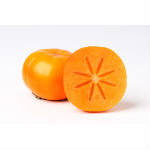Hello all and happy weekend! Autumn is in the air and our bins are a reflection. We are very excited about some awesome items that are back this season.
We are especially excited for fuyu persimmons! For those of you who aren’t familiar,  the persimmon is a very unique fruit resembling a tomato but sweeter. Depending on it’s firmness, it can be sliced like an apple, or mushed like pudding. It’s rich in nutrients and history. Let’s explore…
the persimmon is a very unique fruit resembling a tomato but sweeter. Depending on it’s firmness, it can be sliced like an apple, or mushed like pudding. It’s rich in nutrients and history. Let’s explore…
There are hundreds of varieties of persimmons, with only about 2 that are easily available commercially – the fuyu and the hachiya. They are generally divided into two groups: the astringent (bitter) and the non-astringent. The fuyu belongs to the non-astringent types because it is palatable both before and after fully ripening, where as the hachiya belongs to the astringent varieties, which are only edible after fully ripening.
The fuyu persimmon is a deeply orange fruit that is firm, crispy and delicately sweet when not fully ripe and darker, jelly-like and amazingly sweet when fully ripe. Now it is hard to relate to you the “sweet” taste that I am talking about, especially given that most fruits are “sweet.” Well this “sweet” is honestly like nothing I have ever tasted before. It is not an overwhelming or nauseating kind of sweet, but a unique, deep honey and deliciously rich type of sweet. I am sure that it will not please some people’s taste buds, as not all things do, but generally speaking it is something that everyone must try for themselves to see just how good it really is.
The fruit fits in the palm of a hand, slightly smaller than an apple and looks like a mini-pumpkin.
This fruit was native to China thousands of years ago and then introduced in Japan. Since then, the persimmon has become Japan’s national fruit and one of the traditional foods of the Japanese New Year. The persimmon fruits first arrived in California in the mid 1800s, making it one of the earliest commercially grown fruits in the United States.
Researchers from Israel found that the contents of total, soluble, and insoluble dietary fibers, total phenols, epicatechin, gallic and p-coumaric acids, some minerals in persimmons are significantly higher than in apples.
The fruits of some persimmon varieties contain antioxidant and specifically flavonoid properties. Scientists are still trying to learn about these compounds, but to date we know that they show great promise for optimizing health. Specifically most persimmons contain the tannins catechinand gallocatechin, as well as the anti-tumor compounds betulinic acid and shibuol.
The anticarcinogenic and antimutagenic potentials of tannins may be related to their antioxidative property, which is important in protecting cellular oxidative damage. Tannins are also antimicrobial. Tannins have also been reported to exert other physiological effects, such as to accelerate blood clotting, reduce blood pressure, decrease the serum lipid level, produce liver necrosis, and modulate immunoresponses.
Selection and storage
Astringent variety persimmon fruits are harvested when they are hard but fully matured. Non-astringent persimmons are ready to harvest when they fully colored and slightly soften. Astringent persimmons can continue to ripen at room temperature. Both kinds of persimmons should be plucked from the tree using hand-held pruning shears (as in mango), leaving the calyx intact unless the fruit is to be used for drying while taking care not to bruise.
In the store, select fresh fruits with bright yellow-orange color without bruises or cuts on them. “Dried permissions” are also available readily in the supermarkets and have similarities with dried apricots.
Mature, hard astringent persimmons can be stored in the refrigerator for several months. Non-astringent varieties have short shelf life and can be stored for only a few days at room temperature.
Preparation and serving methods
Persimmons can be eaten fresh, dried or cooked. Raw, fresh fruits can be cut into quarters or eaten wholesome like an apple. Their flavor ranges from firm to mushy and is very sweet.
Here are some serving tips:
- Dried persimmon fruits can be used in cookies, cakes, puddings, salads and as a topping for breakfast cereal.
- Persimmon fruit pudding is a popular dessert using fresh persimmons.
- Dried fruits are also used as snacks or used in desserts. They are used widely to make the traditional Korean spicy recipe, sujeonggwa, while the matured, fermented fruit is used to make persimmon vinegar called “gamsikcho”




